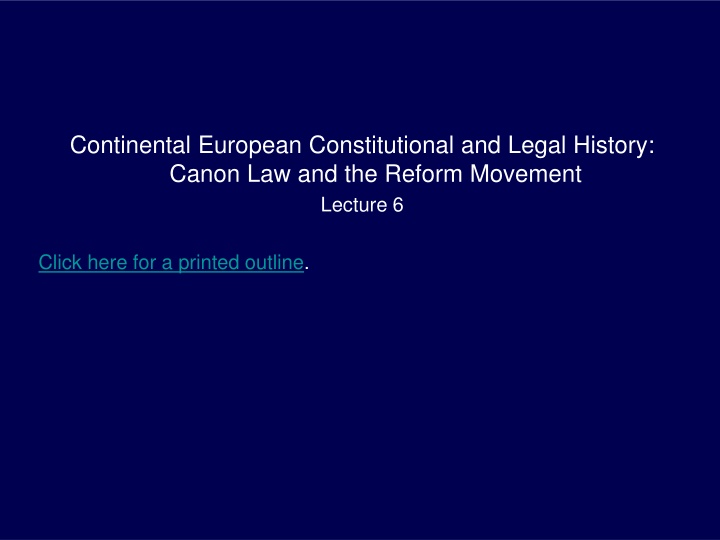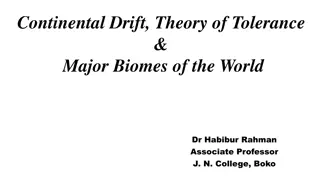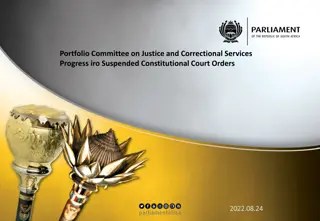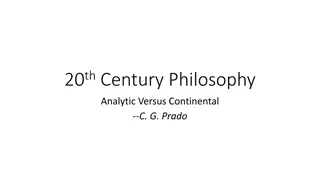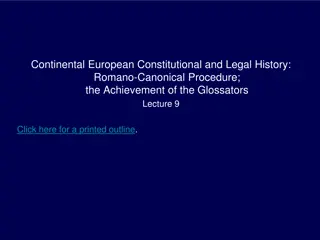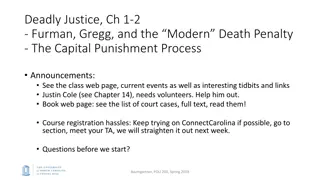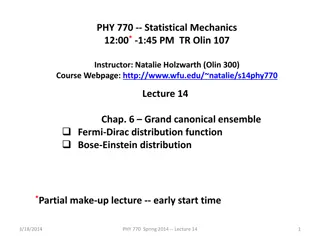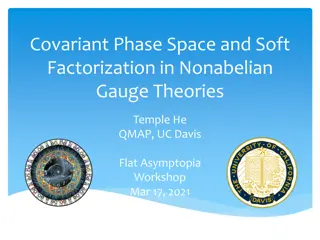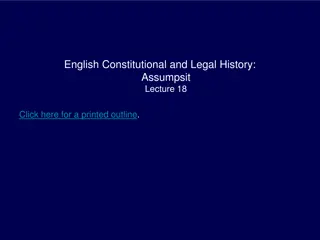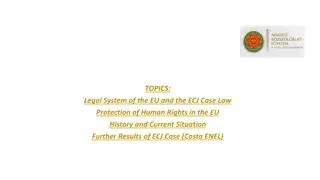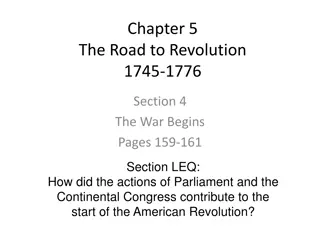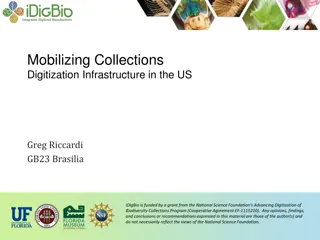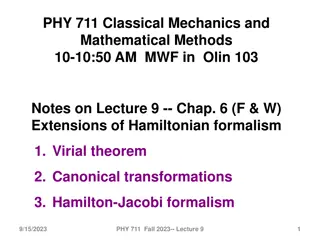Overview of Canonical Collections in Continental European Constitutional and Legal History
The lecture delves into the influence of canon law and the reform movement on the development of legitimacy and governance in the 11th century, shaping the concept of the rule of law in the Western world. It discusses early Church canons, canonical collections such as Dionysiana and Hispana, and the organization of decrees by Gregory IX. The main focus is on the evolution of legal principles and the impact of the reform movement on jurisprudence.
Download Presentation

Please find below an Image/Link to download the presentation.
The content on the website is provided AS IS for your information and personal use only. It may not be sold, licensed, or shared on other websites without obtaining consent from the author.If you encounter any issues during the download, it is possible that the publisher has removed the file from their server.
You are allowed to download the files provided on this website for personal or commercial use, subject to the condition that they are used lawfully. All files are the property of their respective owners.
The content on the website is provided AS IS for your information and personal use only. It may not be sold, licensed, or shared on other websites without obtaining consent from the author.
E N D
Presentation Transcript
Continental European Constitutional and Legal History: Canon Law and the Reform Movement Lecture 6 Click here for a printed outline.
Introduction Pur avoider le stuffing del rolls ove multip If we put together the story that we told in the last lecture and the story that we will tell in this one, we may suggest that the church in the 11th century had a great deal to do with producing a notion of legitimacy that was so important in bringing the local castellans into the sphere of something that bears some resemblance to lawful governance. Local castellans are not dealt with explicitly in the material that we will talk about in this lecture, but there may have been a trickle-down effect from what we will be talking about. 74T may be a better illustration of the mind-set of the church lawyers of the reform movement than is the dictatus papae (Mats., p. V 8) that Harold Berman uses. Berman probably overemphasizes the importance of the reform movement for what came next, the revival of jurisprudence at Bologna. The reform movement and the investiture controversy did, however, have an important effect on the development of the idea of the rule of law in the West. Law in the early Church: kerygma and didache. Canons of early church councils. See Mats. pp. V 9 to V 11. Little search for principle; no building of a legal system.
Main Canonical Collections Prior to 74T Dionysiana (early 6th c.) In two parts: the first (2d ed.) contains Greek councils from Nicaea (315) to Chalcedon (451) and the African Codex of the council of Carthage (419); the second 39 decretal letters of popes from Siricius (384 99) to Anastasius (496 98). Hispana (1st ed. c. 633; 2d ed. c. 694). Contains, in chronological order, the Greek councils, the African councils, the Gaulish councils to 511 (549 in 2d ed.), the Spanish councils to 633 (694 in 2d ed.), 104 decretals up to Gregory I (604). The Tabula of the Hispana (mid-7th c.) arranges the canons in the following titles: 1. Ordination, orders, the life of the clergy 2. Monks, nuns, widows, public penitents. 3. Church courts, trials, accusations, etc., councils, church property 4. Liturgy, baptism 5. Marriage, sins of the flesh, murder 6. Duties and moral conduct of clergy and laity 7. The crown 8. Theological questions
Main Canonical Collections Prior to 74T (contd) The Tabula of the Hispana (mid-7th c.) arranges the canons in the following titles: 1. Ordination, orders, the life of the clergy 2. Monks, nuns, widows, public penitents. 3. Church courts, trials, accusations, etc., councils, church property 4. Liturgy, baptism 5. Marriage, sins of the flesh, murder 6. Duties and moral conduct of clergy and laity 7. The crown 8. Theological questions 9. Heresy 10. Idolatry, apostasy The organization of the Decretals of Gregory IX (1234): hierarchy, procedure, substantive rights and duties, marriage, and crimes (iudex iudicium clerus conubia crimen).
Main Canonical Collections Prior to 74T (contd) The Penitentials (5th to 8th c.). The example of an Irish penitential of c. 800. When we looked at this before, we said that it reminded us of Aethelbert s Code. Instead of composition payments for homicide we have penances, composition, one might suggest, to God. We also found an offense that is not normally an offense in secular law, and if it is, it is an offense only in sophisticated secular laws, like our law of libel and slander. This provision goes further than simply publicizing another person s faults. It makes the culpability of the wrongdoer depend on his inner conviction, his motivation for doing it. Behind this must lie some kind of procedure in which the wrongdoer is seeking forgiveness for what he has done, a procedure that is not adversary, and that procedure is the procedure of penance. In a later age much of this will take place in the privacy of the confessional; whether it did so in 8th century Ireland is a matter of some controversy, but it seems probable. It is also possible that the seeking of forgiveness took place within a penitential setting in a monastic community, the only group in 8th century Ireland who would have been likely to be able to perform the alternative penance, reciting the Psalms by heart.
Main Canonical Collections Prior to 74T (contd) The penitentials made their way across northern Europe in the wake of conversions. We find them in England in the seventh century. When Anglo-Saxon and Irish missionaries went to Germany in the eighth century, penitentials came with them. Here they encountered some resistance during the period of the Carolingian reform. Charlemagne s attempts to reform the church included efforts to root out local abuses that were associated with an overly Germanic and Celtic church. The penitentials were notable both for their great diversity, their variation at least in some instances from the traditional discipline of the church (divorce is a notable example), and, surprisingly enough, for their laxity, because it was possible to commute the penances by paying fines. The Dionysio-Hadriana. Basically the Dionysiana to which have been added decretals of Hormisdas (d. 523) and canons of the Roman Synod of 721. The new material is in PL 67.315 46. The collection was transmitted to Charlemagne in 774 by Pope Hadrian, hence the name. .
Main Canonical Collections Prior to 74T (contd) The Forgeries Problems addressed How did the church fit into feudal society? Bishops and abbots were great lords; what did this mean for the organization of the church? What was the role of the archbishop, particularly a reforming archbishop like Hincmar of Reims (845 882), in his relationship with the king, with the bishops, and with the pope? Great and lesser lords founded churches, Eigenkirchen, they are called in German, literally owned churches. What did this mean so far as the appointment of the parish priest was concerned? Lay investiture. If a bishop, or even a parish priest, was in some sense the feudal vassal of the king or local lord, from whom did he receive his authority to act? .
Main Canonical Collections Prior to 74T (contd) The pseudo-Isidorean forgeries (all c. 850) Capitula Angilrami Capitularia Benedicti Levitae Isidorus Mercator The forgers did a good job. Until the Renaissance, most of what was in the Pseudo-Isidorean collections was unquestionably accepted as genuine, and it was not until the middle of the sixteenth century that the falsity of them was proven to the satisfaction of many scholars on both sides of the religious divide. It was not until the 19th century that their falsity was universally accepted. The bias of the collections is hard to tell., They probably emerge from episcopal circles, because they at once extoll the power of the bishop at the expense of the metropolitan and of lesser ecclesiastical dignitaries. They also exalt the power of the pope, but they do not come from Rome. The Carolingians, though they clearly have the power to discern principles, clothe them in the authority of antiquity. A later age would seek to answer questions by reasoning from the materials that they did have; a still later age would make use of legislation. .
Main Canonical Collections Prior to 74T (contd) Regino of Pr m, Libri duo de synodalibus causis et disciplinis ecclesiasticis (c.900) Burchard of Worms, Decretum (c. 1010) Eclectic sources of law : canons of councils, papal decretals, falsifications of the first two (together with some material from secular capitularies both genuine and false), extracts from penitentials, extracts from the Bible, extracts from the fathers of the church (notably Augustine, Gregory, Ambrose and Jerome).
The Reform Movement and the Investiture Controversy Popes Leo IX, 1049 54 Emperors Henry III, 1039 56 Humbert of Silva-Candida d. before 1065 (1st generation, simony and celibacy) Alexander II, 1061 73 (2d generation, the problem of investiture comes to the fore) Gregory VII, 1073 85 Henry IV, 1056 1106 (Canossa, pope and emperor depose each other) Others Peter Damian, d. 1072 74T written ?before 1073 Ivo of Chartres, 1040 1116 1st Crusade, 1095 1099 Henry I (England), 1100 27 Philip I (France), 1060 1108 Urban II, 1088 99 Paschal II, 1099 1118 Henry V, 1106 25 (Radical reform proposal and compromise: Concordat of Worms 1122)
The Reform Movement and the Investiture Controversy (contd) The traditional story: In the time of Charlemagne, church and state worked together. The emperor and his bishops were partners in government, but the emperor had the upper hand. In the time of emperors Henry II and Henry III this partnership continued, with the emperor leading the reform movement. During the minority of Henry IV, the papal party took over, leading to the investiture controversy. The settlement of the investiture controversy, by and large, favorably to the emperor and the kings, was followed by a period of relatively weak kings and emperors in the early to mid 12th century. During this period the popes put their legal system into operation. This leads to the conflict with Barbarossa in the late 12th century, settled favorably to the papacy because of the revolt of the Lombard cities.
The Reform Movement and the Investiture Controversy (contd) The traditional story (cont d) Things blew up again in the middle of the 13th century with Frederick II, deposed by Innocent IV at the council of Lyon in 1245. Angevins and northern Guelfs drove imperial power from Italy, but the triumph of the papacy did not last long because of: The conflict between Boniface VIII and Philip IV (the Fair) of France (1298 1304), which lead to the Babylonian Captivity of the papacy at Avignon. What s wrong with this account? This is not a story about church and state not because people didn t know what the church was but because they didn t know what the state was. I would suggest therefore that we speak of a conflict between royal and priestly power, kingship and priesthood in Tierney s translations, regnum and sacerdotium in Latin; we might also talk about temporal and spiritual. Both dichotomies would has been understood in the 11th and 12th centuries. But the church encompasses both sides of the dichotomies, and that is not the least of the problems.
The Reform Movement and the Investiture Controversy (contd) The Reform Movement In the 11th century, there was an extensive church reform program. Of a large number of issues we might mention simony (the sale of ecclesiastical offices), clerical marriage, ecclesiastical property, investiture, general reform of morals both clerical and lay, Roman primacy, and episcopal primacy. Not all of the reform movement was concerned with power relationships with secular authorities. It was a broad program in which internal reform played a very important role. The extracts in Part V of the Materials are obviously important for political theory and constitutional development. At the end of the reform movement regnum and sacerdotium, to use modern and anachronistic terms, are established as powers neither of which can completely dominate the other. The rule of law is necessary if everything is not going to collapse in chaotic warfare, which it sometimes did. Having two coordinate powers also makes people think about what political power is all about. Where does it come from? How is it to be limited? What is the range of legitimate political and legal argument about it?
The Reform Movement and the Investiture Controversy (contd) The Reform Movement (cont d) The importance of the reform movement for law, more strictly speaking, is another matter. For our purposes probably the most important thing about the documents in Part V is the way that both sides make use of material in the tradition to marshal authorities for their side of the argument. The collections themselves may not be very systematic but there is no doubt that these guys knew how to make an argument based on authority. Stages of the reform movement. The late 9th and early 10th centuries were bad times throughout Europe because of the Viking invasions, renewed attacks by Muslims, and attacks by the Magyars. The papacy was not exempt from this general decline. With the possible exceptions of John X (914 928) and Sylvester II (999 1003), at the beginning and end of the 10th century, respectively, the holders of the see of Peter in the 10th and early 11th centuries were an undistinguished lot, and many were a lot worse than that.
The Reform Movement and the Investiture Controversy (contd) Stages of the reform movement (cont d). But the seeds of reform were planted in northern Europe quite early with the founding of the great abbey of Cluny in 910. By the beginning of the 11th century Cluny was the head of a large number of reformed Benedictine abbeys, and the time had come to move the reform into the secular world. The man who began the general reform movement was Henry II, the German emperor, 1002 1024. His vision of reform was like that of Charlemagne. Church and secular power would work together under the leadership of the emperor to reform the clergy and through them society. His cousin, Conrad II, and Conrad s son, Henry III, continued his policies. When Henry III arrived in Rome for his coronation in 1046, three rivals were contending for the papal throne each supported by a faction of the local nobility. Henry deposed them all and installed his own man as pope. The first two men that Henry placed on the papal throne died quickly, poisoned, it was rumored, by the locals. But the third, Leo IX, began the reform movement in Rome in earnest.
The Reform Movement and the Investiture Controversy (contd) Stages of the reform movement (cont d). Leo brought to Rome an extraordinary group of reforming cardinals. We can only mention three of them here: St. Peter Damian (1007 1072/3) is probably the most attractive of the three, a reformer but a moderate in politics. Humbert of Silva-Candida (1000 X 1015 1061) was much more radical. Hildebrand, later Gregory VII (1020 1085), was the youngest of the three, worked as an administrator until he became pope. During Leo s pontificate, relations with the emperor were cordial, and the reform program worked on the twin difficult issues of simony and clerical celibacy. Henry IV was only six years old when he became emperor, and the old reformers saw to it that Alexander II was elected pope without imperial interference. Peter Damian, as papal legate in 1069, forced Henry to marry the woman to whom he had been espoused. Papal power was seeming to get the upper hand. d. The crisis was brewing in the last years of the pontificate of Alexander II, when it became clear that Henry IV would not follow the reforming policies of his father and of Henry II. Henry IV backed off
The Reform Movement and the Investiture Controversy (contd) Stages of the reform movement (cont d). The crisis was brewing in the last years of the pontificate of Alexander II, when it became clear that Henry IV would not follow the reforming policies of his father and of Henry II. Henry IV backed off during the early 1070s when he was faced with a rebellion in Saxony, but when the rebellion was quelled in 1075, Henry returned to his old ways, appointing his men as bishops and investing them with their sees. The crisis reached a height in 1076 when Henry and Gregory mutually deposed each other, and Gregory excommunicated Henry. If you remember nothing else from this course, you ought to remember the wonderful legend that in January of 1077, Henry stood for three days barefoot in snow at the gates of the castle of Canossa until Gregory absolved him.
The Reform Movement and the Investiture Controversy (cont d)
The Reform Movement and the Investiture Controversy (contd) Stages of the reform movement (cont d). The crisis, however, was renewed in 1080 by the emergence of a rival claimant to the imperial throne whom Gregory supported, and Henry was once more excommunicated. The struggle continued during the pontificate of Urban II; there was an anti-pope for a period. After a number of years, Urban finally succeeded in gaining the upper hand, when Henry s support in Germany once more turned against him. Urban s preaching of the first Crusade in 1095 turned European attention to the East, and when Henry IV died in 1106, his son Henry V was already leading an armed rebellion against him. The settlement of the Investiture controversy was left to new men. Already at the end of the 11th century Ivo of Chartres had proposed the idea that canonical elections should be free but that the king would invest bishops with their temporalities before they were consecrated by their metropolitans. The idea was accepted Philip I in France and Henry I in England. It took until 1122 for it to be agreed to in the Empire, during which period Pope Paschal II (probably) proposed that the bishops give up their temporalities, a suggestion that no one would agree to.
The Reform Movement and the Investiture Controversy (contd) The topics of the reform movement. At the end of the 10th and the beginning of the 11th century churchmen, and at least some laymen, began to look around them, and they didn t like what they saw: In the centuries preceding the 11th, the church had been called upon more and more to support the defense of the realms in which it found itself, to use its lands to support knights. The Carolingian of kingship was theocratic, sacral. Coronation was a kind of orders giving the king, and particularly the emperor, a sacred character. By the 11th century these two ideas had combined to turn bishops and abbots into great feudal barons. They were appointed by the king. They received the regalia of their office, including the ring and staff, which were symbols of their spiritual authority, from the king or emperor. They did homage to him. They lead their knights into battle. The feudalization of the church was accompanied, perhaps inevitably, by serious abuses: Simony was rampant. The ideal of clerical celibacy was hardly even preached much less observed.
The Reform Movement and the Investiture Controversy (contd) The topics of the reform movement (cont d). Religious observance in monasteries was lax or worse. At the parish level religious observance hardly existed. Also at the parish level feudalization of a different sort had taken place. The local lord owned the church, and the parish priest was the lord s man. In the first wave of reform, the emperor Henry II (1002 1024) of Germany led an essential monastic reform movement. He and his empress Kunigunde were canonized as saints. The separation of the ecclesiastical and spiritual courts by William the Conqueror and his reform program with Archbishop Lanfranc in the mid 11th century may be seen as part of this tradition. The second wave of reform comes in the mid 11th century and is associated with Gregory VII, although its first manifestations lie in the pontificate of Leo IX. The Gregorian program of reform is an interesting one: An end to simony, which in turn leads to: An end to lay investiture, and to: An end to lay ownership of churches.
The Reform Movement and the Investiture Controversy (contd) The topics of the reform movement (cont d). Enforcement of clerical celibacy, so that churches don t become like private property passed down in families. General moral reform And to achieve all these things a recognition of the primacy of spiritual power over temporal, of the power of the pope over that of any lay magnate. The element of this program which caused the most immediate controversy was lay investiture. This did not become a serious issue until the middle of the 11th century. Almost everyone, lay and cleric, agreed that moral reform was desirable, however unwilling he might be to reform himself. The general argument about political power in the 11th century came to bear only on the question of lay investiture. The problem was symbolic but also practical. Land gave power, and no monarch was willing to see anyone in his realm acquire the power of a bishopric without having control over who the bishop would be.
The Reform Movement and the Investiture Controversy (contd) The topics of the reform movement (cont d). That to a certain extent tells us why the question could not be resolved by the modern solution of separation of church and state. But the problem ran deeper: No one in the 11th century and very few in the 12th could conceive of the office of bishop being separated from the land, so intertwined had land and office become. It is only in the early 12th century and England must be given the credit for being the first to implement it was a way out perceived. The division of homage from investiture allowed the church to win the symbolic issue, while the kings retained their practical control. In another sense, of course, the Gregorian reformers were way ahead of their time. They wanted separation of the church from secular society. They wanted the clerical state separated from the lay to symbolize the separation of the spiritual from the temporal. They also, however (and this is decidedly not modern) wanted the spiritual to control the temporal. Much of the history of the conflict between regnum and sacerdotium is bound up in men s inability to escape from the syllogism: The soul controls the body, therefore, the pope should control the emperor. The investiture controversy was settled, but the conflict remained.
The Reform Movement and the Investiture Controversy (contd) The topics of the reform movement (cont d). Constitutional history is full of documents which were not fully put into effect at the time but which were statements of an ideal to which men returned in times of crisis. Magna Carta (1215) is a notable example. On the other hand, the dictatus papae of Gregory VII in 1075 (Mats. p. V-8, and on the outline), like the Constitutions of Clarendon of 1164, which provoked the controversy between Henry II of England and Thomas Becket, illustrate a different point: the danger of writing things down that do not represent a consensus or at least a groping for one. Gregory VII may have made a serious mistake in trying to clarify a fluid situation too early. Henry IV might have agreed to an oral compromise. His political situation was none too stable, and he needed political support. But Henry s lawyers and the documents in Part V show that he had some could not agree to the bald statements of the dictatus, just as Pope Alexander III could not agree to the bald statements of the Constitutions of Clarendon.
The Reform Movement and the Investiture Controversy (contd) The topics of the reform movement (cont d). A working compromise of the investiture controversy was reached in the early years of the 12th century, just as a working compromise of the Becket controversy was reached in the early years of the 13th century. But the presence of dictatus, just like the presence of Clarendon, meant that it was never possible to solidify the compromise, and the result was considerably more friction than there need have been. It has been suggested that the role of the conflict between regnum and sacerdotium was crucial to the development of the notion of the rule of law in the Middle Ages. Most societies as they develop materially tend toward autarchy. Western society did not end up this way, though the tendency is manifest in a number of periods. It may well be that the presence of the church, with its cross-cutting loyalties, its institutional structures that could not be overcome by secular government is the place where we ought to look to see why this development happened. But if the kings and the emperor could not dominate the church, the church could not dominate the kings and the emperor. A compromise had to be worked out, and that compromise tended to be represented by law.
The Reform Movement and the Investiture Controversy (contd) The topics of the reform movement (cont d). A note of caution: Ecclesiastical theory had a role for kings and emperors, just as it had a role for the pope, the bishops, and the lower clergy. It had no formal role, however, for lordship. But lordship, as revised and modified, is also crucial to understanding how the late medieval constitution was formed. It is to that to which we will turn when begin to look at customary law. How does all of this tie into the reform movement? The church, as we just saw, and will see in more detail in the future lectures, was developing a legal system in the modern sense. That means that there will be courts in which the legal system will be applied. Kings were also developing legal systems, more slowly, but nonetheless developing them. The one in England was, perhaps, the earliest. France probably followed. For the Empire north of the Alps in this period we are very poorly informed, though we have some evidence for northern Italy, but there the development seems to mostly at the level of the city-state rather than the Empire.
The Reform Movement and the Investiture Controversy (contd) The topics of the reform movement (cont d). Whether the development of these separate legal systems is the product of the conflict between regnum and sacerdotium, or whether the conflict is its cause, as Berman argued, is sometimes hard to see. Indeed, we may be dealing with mutual causation. In our struggle to understand we should keep two things in mind. (1) The potential for conflict was great, and sometimes it broke out, but cooperation was frequently the order of the day. (2) We should not underestimate the power of competition. In a world of multiple jurisdictions, some jurisdictions will gain a greater share by providing better justice. This seems to have been the case with the central royal justice as opposed to seigneurial justice in England in the late 12th century. I think it is also the case with ecclesiastical justice at least in some subject-matter areas in the same period..
The Collection in 74 Titles The received view is that 74T was probably composed before the pontificate of Gregory VII began, i.e., probably before 1073, almost certainly after 1050. The organization of 74T (on the outline) is certainly no improvement over Burchard. That overall organization, by and large, follows Pseudo- Isidore. Pseudo-Isidore s overall order in turn is dependent on the order of the tabula to the Hispana. The titles are new. The author s method, largely, is to follow the order of the material within Pseudo-Isidore, which, in turn, is his main source. He is very short on conciliar canons, suggesting that he used a copy of Pseudo-Isidore that didn t have them. In comparing him with Burchard, he goes very light on what we would call private morality. He has, for example, nothing on fasting and nothing on gluttony. Like all reformers, he probably thought that people should fast at appropriate times and that they should not be gluttonous, but his work is focused almost exclusively on public institutions, including public courts. He makes some changes in his material, but not enough that we can tell whether the changes are tendentious or simply abbreviations and/or mistakes.
Selections from 74T The first three titles On the Primacy of the Roman Church, That Peter and Paul Suffered on the Same Day, and On the Authority of Privileges are tied together, constituting a juridical view of the papacy, perhaps a juridical view of the world. c. 1 (Deut. 17:8 13): If you perceive that there is a hard and doubtful judgment among you between blood and blood, cause and cause, and if you see the words of the judges do vary within your gates, arise and go to the place which the Lord your God shall choose, and come to the priests of the tribe of Levi and to him who shall be the judge at that time, and ask of them and they shall show you the truth of the judgment. And you shall do whatever they who preside in the place which the Lord has chosen shall say, and what they shall teach you according to his law. You shall follow their pronouncements and shall stray neither to the right nor to the left. But he that shall be proud, refusing to obey the command of the priest who at that time serves the Lord your God, and the decree of the judge, that man shall die. And you shall take away wickedness from Israel, and all the people hearing shall fear, so that henceforth no one shall be filled with pride. This is an important proof text in Talmudic commentary in period of 74T. It is just possible that the author of 74T got it from the Roman Jews. Later collectors, by and large, don t use it.
Selections from 74T This is an important proof text in Talmudic commentary in period of 74T. It is just possible that the author of 74T got it from the Roman Jews. Later collectors, by and large, don t use it. tit.5: On the procedure for accusation and those who accuse. Every c. in this title is false. The theme is that the accuser must be a witness and that the ancient rules for witnesses apply. Laymen and clerics are separated. No accusation is valid if the accuser is unworthy. For example, c.48 (Pseudo-Callixtus [217 22]): The character of accusers must be thoroughly examined. Never should they be received in writing and only with difficulty in person, because no one can be accused in writing, but everyone should make his own accusation in his own voice and in the presence of him whom he wants to accuse. Nor should any accuser be believed in the absence of the person whom he wishes to accuse. Similarly, witnesses should not proffer any testimony in writing, but, being present, they should give true testimony of what they have seen and know, nor should they give testimony about other cases or matters, unless about those things that are known to have happened in their presence. (cont d on next slide)Also, accusers related by blood should not give testimony against outsiders, nor should servants or members of the same household, but if they desire and mutually consent,
Selections from 74T (contd) Also, accusers related by blood should not give testimony against outsiders, nor should servants or members of the same household, but if they desire and mutually consent, relatives may testify against one another, though not against others. Nor should suspect accusers or witnesses be received, because the influence of relationship, friendship and lordship often impedes the truth. Carnal love, fear, and avarice very often dull the human senses and pervert opinions in such a way that they consider profit a virtue and money a reward for prudence. tit.10: On the Judgment and Trial of Bishops. It s almost impossible to convict a bishop. For example, c.84 (Pseudo-Zephyrinus [198-217]): Patriarchs or primates examining an accused bishop may not pass a definitive sentence before they have consulted the apostolic authority, or [before] the accused confesses his guilt, or is convicted by the testimony of reliable and properly examined witnesses. These witnesses should not be fewer in number than those disciples whom the Lord chose to assist the apostles, that is, seventy-two. 4. Marriage and eclectic sources of law: a. Before we get to the marriage titles in 74T (tit. 62 64), let us look at two Carolingian treatments of the topic, one of which is in 74T and the other of which is not.
Selections from 74T (contd) Marriage and eclectic sources of law: Before we get to the marriage titles in 74T (tit. 62 64), let us look at two Carolingian treatments of the topic, one of which is in 74T and the other of which is not. The one that does not is Pope Nicholas I s, Reply to the Bulgarians (866). It is addressed to Boris Michael, the khan of the Bulgarians, who became a Christian a couple of years prior to the date of this letter. He sought to distance himself from the influence of the Greeks who had converted him and posed 106 questions of the pope. This is the answer to the third question. Avoiding the verbiage that would be necessary to rehearse the custom that you say that the Greeks have in marital unions, we will strive immediately to show you the usage that the Holy Roman Church had of old and still has in this kind of union. Our people, both men and women, do not wear on their heads filigree of gold or silver or any other kind of metal when they contract nuptial covenants, but after espousals, which are the promised covenants of future nuptials, are celebrated by the consent of those who contract these things and with that of those in whose power they are, (cont d on next slide)
Selections from 74T (contd) and after the espoused man gives earnest to the espoused woman by placing a ring on her finger of faith, and [after] he has handed over to her before those who are invited the dos that was agreed on with a writing containing this thing, either soon or at an appropriate time, lest such a thing be presumed to be done before the time defined by law, both are led to the nuptial covenants. And first they stand in the church of God with offerings, which they ought to offer to God by the hand of the priest, and then at length they receive the blessing and the heavenly veil, after the example of the Lord who blessed the first men in paradise, saying Increase and multiply, etc. [Genesis1:28: And God blessed them and said: Increase and multiply , etc. ] Indeed, Tobias, also, before he came together with his wife, is said to have prayed to the Lord with her. [Tobias 8:6 10] Nevertheless, those who are marrying for the second time do not receive the veil. Afterwards they leave the church carrying crowns on their heads, crowns that are commonly kept in the church. And the nuptial feast having been celebrated, they direct their way to leading an undivided life thereafter, the Lord willing. These are the laws of nuptials (iura nuptiarum); these are the solemn pacts of marriage unions (except for other things that I do not at present remember). (cont d on next slide)
Selections from 74T (contd) We do not say, however, that it is a sin if all of these things are not present in a nuptial covenant, as you say that the Greeks are instructing you, particularly when such great poverty can constrain some people that they do not have the means to prepare these things, and for this [reason], the consent alone of those whose joining is at stake suffices according to the laws (leges). If this consent alone is lacking, everything else, even if it is accompanied by carnal union, is frustrated, as the great doctor John Chrysostom testifies when he says Carnal union does not make marriage but will . Espousals, which are the promised covenants of future nuptials is probably derived from D.23.1.1: Espousals are the proposal and promise back of future nuptials. If it is, it is the last time that the Digest is cited in the West until Ivo of Chartres does so in the late 11th century. The following material on parental consent may also be from D.23.1, but it need not be, because the same requirement is to be found in JI.1.10pr (Materials I 6), though there it applied to marriage not to sponsalia.
Selections from 74T (contd) [H]e has handed over to her before those who are invited the dos. Dos in classical Roman law was dowry, a payment made by the bride or the bride s father (or relatives) to the groom. Here, a payment by the bridegroom seems to be contemplated. Such payments were known to the classical Romans, at least in the later Empire, but they are never called dos but gift before nuptials (donatio ante nuptias). On the basis of this text, it has been suggested that the Germanic custom of the husband s making a marriage payment had penetrated as far south as Rome in the mid-ninth century. [T]he time defined by law. There was no fixed period in Roman law that had to elapse between the espousal and the nuptials. This is either a reference to the minimum ages for marriage fixed by Roman law (12 for the bride, 14 for the groom) or it is a reference to the period fixed by the agreement of espousals (the word lex being used in Roman law not only for laws passed by the Roman people but also those to which parties bind themselves by private agreement).
Selections from 74T (contd) [D]irect their way to leading an undivided life thereafter. Perhaps an echo here of the definition of nuptials in JI.1.9.1: Nuptials, moreover, or matrimony is the joining of man and woman, involving an undivided habit of life. According to the laws. It is probably significant that Nicholas says according to the laws (leges) and not according to the canons (canones), i.e., he is referring to Roman law. Carnal union does not make marriage but will. Not by John Chrysostom but by an anonymous author of a collection of homilies on Matthew s Gospel. The mistaken attribution is old, and probably antedates Nicholas. That Nicholas is citing a great father of the Greek Church in the context of an argument with the Greeks will not escape notice. The other text is a part of a letter of Pseudo-Evaristus to all the bishops of Africa. Likewise we have it held and handed down that a wife be lawfully joined to a man. As we have taken from the fathers and find handed down by the holy apostles and their successors, a marriage cannot otherwise be legitimate (cont d on next slide)
Selections from 74T (contd) unless the wife is sought from those who have lordship over the woman and by whom she is protected; and she is espoused by her near kin and dowered; in accordance with the laws, and she is sacerdotally blessed at the proper time, as is the custom (mos), with prayers and offerings by a priest; and, accompanied by bridesmaids, as custom (consuetudo) teaches, and escorted and accompanied by those closest to her, she is solemnly given and received at a suitable time according to the laws. Let them spend two or three days in prayer and preserve their chastity, so that good offspring might be produced, and they may please the Lord and beget not bastard sons, but lawful and legitimate heirs. Therefore, most beloved sons and those of high status by merit, know that marriages performed in this manner, the catholic faith supporting, are lawful; but have no doubt that unions made otherwise are not presumed to be marriages, but either adulteries, or concubinages, or lusts, or fornications rather than lawful marriages, unless proper will supports and lawful vows undergird. Evaristus was the bishop of Rome, traditionally from 99 107. The first pope to write extensively in Latin is Damasus (d. 386). The first pope known to have written anything in Latin is Victor I, probably 189 199. That this text was not written by Evaristus is as certain as any historical proposition can be.
Selections from 74T (contd) The text first appears in Pseudo-Isidore, written around 850, and hence roughly contemporary with the letter of Nicholas I. There are no known exact parallels prior to Pseudo-Isidore, though similar requirements appear in earlier canonical collections, all from Northern Europe or Ireland. The contrast between Nicholas I and pseudo-Evaristus is pretty obvious. Nicholas I does not seem to require anything but consent for the validity of a marriage, whereas pseudo-Evaristus has what at least seems to be a panoply of formal requirements. The marriage provisions in 74T are found in tits. 62 64. There are only five canons given in the three titles. The author of 74T does not seem to have been particularly interested in the topic, and does not present a coherent view of marriage. He includes: tit. 62: c. 271. On Lawful Marriages. This is a truncated, but fairly accurate, version of the text from Pseudo-Isidore quoted above. Apparently the author of 74T thought that he had to put in something on the formation of marriage. He does not include the canon of Nicholas I to the Bulgarians; he may not have known it. He chose pseudo-Isidore. c. tit. 63: c. 272. On Marriages For Some Reason Separated. This is a genuine letter of Pope Leo the Great, dated in 458 AD. It holds that
Selections from 74T (contd) tit. 63: c. 272. On Marriages For Some Reason Separated. This is a genuine letter of Pope Leo the Great, dated in 458 AD. It holds that when a man has been captured in war and then returns, his wife, who has remarried, is to return to her former husband. Leo is writing in the context of the Roman law of postlimium. Those who were captured by the enemy were considered dead unless and until they escaped and returned. The author of 74T may have been puzzled by this text, because it does not take as strict a view of the indissolubility of marriage as the reformers did. tit. 64: c. 273, 274, and 275. That Marriages Must Not Be Dissolved For The Sake Of Religion. The first two canons are derived from genuine letters of Pope Gregory I, probably written in the year 600. Both hold, contrary to the law of Justinian, that a married person may not join a monastery without the consent of his/her spouse. The ruling is supported with extensive quotations to the New Testament, passages that we examined in the first lecture. The suggestion in both of Gregory s texts is that the marriage is indissoluble because the two are one flesh. e. The last text does not belong in this title. It is also a genuine letter of Gregory I, dated June, 593. It holds that despite what the more rigorous secular law says, a man who has seduced the daughter of a
Selections from 74T (contd) The last text does not belong in this title. It is also a genuine letter of Gregory I, dated June, 593. It holds that despite what the more rigorous secular law says, a man who has seduced the daughter of a cleric should either marry her or be punished corporally, excommunicated, and put in a monastery to do penance. The references to the secular law are a bit uncertain, but are probably to be found in CJ 9.9, 10, 11, and/or 12.
Conclusions The Church does not have a comprehensive law of marriage in the mid- eleventh century, but there may have been people who were thinking about the possibility that it might have such a law. The diversity of sources is striking. The authors of these texts are putting together material from a wide range of sources only some of which we would regard as legal. The only thing that we do not find are references to the post-Roman secular laws, and even some of these (particularly the Carolingian capitularies) can be found in pseudo-Isidore, normally rewritten to make them appear as if they were written by early popes or church councils and synods. More can be said about procedural law in 74T. The focus seems to be much more on what we today call criminal procedure than on civil, but there s a lot of material, particularly in Pseudo-Isidore that could be used to construct a procedural system. It seems strange to think that anything so obviously political as Pseudo-Isidore s ideas of what might be appropriate for a trial of a bishop could, in some way, be informing Western ideas of due process. There is, however, some evidence that they did. 3. More generally, the reform movement is obviously important for the development of law in the West. The conflict between empire and
Conclusions (contd) More generally, the reform movement is obviously important for the development of law in the West. The conflict between empire and papacy, kingship and priesthood (regnum and sacerdotium in Latin) could and did lead to something not too far away from what we would call constitutionalism. Neither regnum nor sacerdotium could dominate the other completely. A means would have to be found to draw some lines and allocate powers between the two. The West chose law as that means. The concordat of Worms of 1122 is a good example. Others were to follow. A final, and perhaps more subtle, point: 74T focuses more on law as we understand law with what we call morality left out. Omitting what we would call morality is relatively new in canonic material which had previously combined what we would call law and what we would call morality. That may or may not be a good thing. The western separation of law from morality has its critics, but it seems to be happening here.
